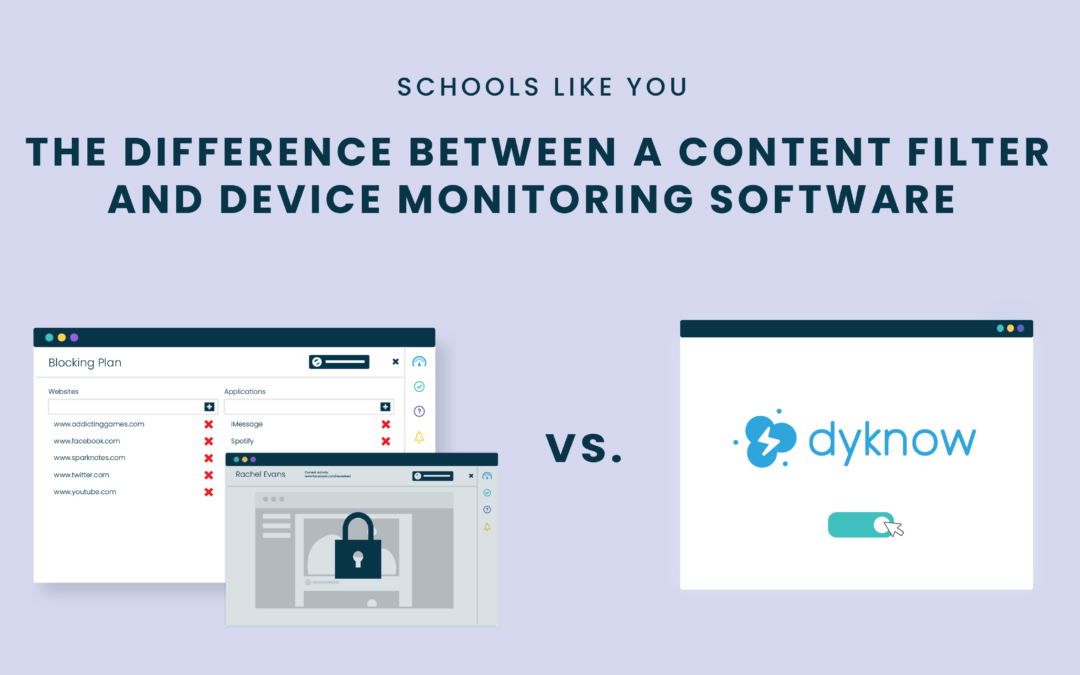As technology becomes standard in the everyday K-12 classroom, concerns around device distractions have become a top-of-mind issue for teachers, admins, and tech coaches. Students are getting off task and getting distracted by websites and apps during school hours and teachers have no way to control it remotely. Schools have tried to combat these issues by implementing content filters and device monitoring software. While both are effective in their own ways, they provide very different support to educators. Do you know the difference?
What are Content Filters?
Content filters are implemented at the school or district level and protect students from inappropriate and dangerous content on the internet. Essentially content filters are a form of blocking on student devices to enhance safety and to increase good digital citizenship of students. Content filters do their job well of keeping students away from distractions. One downside of content filters is that educators cannot always predict what type of distractions students will get themselves into online. Content filters have students in mind but not teachers. Teachers do not have control over what is blocked in their classroom with content filters, meaning that they have to request sites to be blocked by the tech team at the school or district level. Content filters don’t provide the protection that teachers need from device distractions in the classroom.
What is Device Monitoring Software?
Unlike content filters, device monitoring software gives teachers the power and control to protect their class from device distractions. Teachers are able to monitor their students’ screens in real-time during class to make sure they are staying on task and participating like in a typical classroom. If a student wanders onto another site, teachers are able to see that right away and block that site immediately. Device monitoring software supplements content filters at the classroom level, giving teachers autonomy with this control and relieving tech teams of all those blocking requests from teachers. The gaps that content filters present are filled by device monitoring software. Overall teachers have found much success with device monitoring software and the blocking plans that come with it.
Dyknow’s Device Monitoring Software
Primarily, Dyknow is a student device monitoring platform with which teachers can passively or actively monitor student devices during class and create blocking plans to eliminate off-task behavior before it happens. Many teachers are looking to go beyond device monitoring in the classroom, and Dyknow offers great solutions for doing so.
Take a look at some of our blogs to help outline exactly what device monitoring software is, how blocking plans work, and how these tools have impacted classrooms across the country.
Start teaching confidently with Dyknow for free!
Latest blog articles

Dyknow 2021 Year In Review
In addition to web browser updates and bug fixes, Dyknow released several major product updates, new features and enhancements. Check out Dyknow’s 2021 Year in Review!

The Classroom Management Tool that’s Rated #1 in Satisfaction on G2
K-12 Administrators across the world trust G2 as the #1 platform to find, research, and choose EdTech tools that solve the most pressing problems their teachers are experiencing. In G2's Fall 2021 Reports, Dyknow was once again rated #1 in overall Satisfaction out of...

Bringing Diversity and EdTech to the English Classroom
On this episode of Tackling Tech, Tierra Leustig interviews Scott Bayer about being an anti-racist teacher, diversifying reading lists, creating inclusive learning environments, and leveraging ed-tech in non-technical ELA classrooms. Scott Bayer is a High School...

